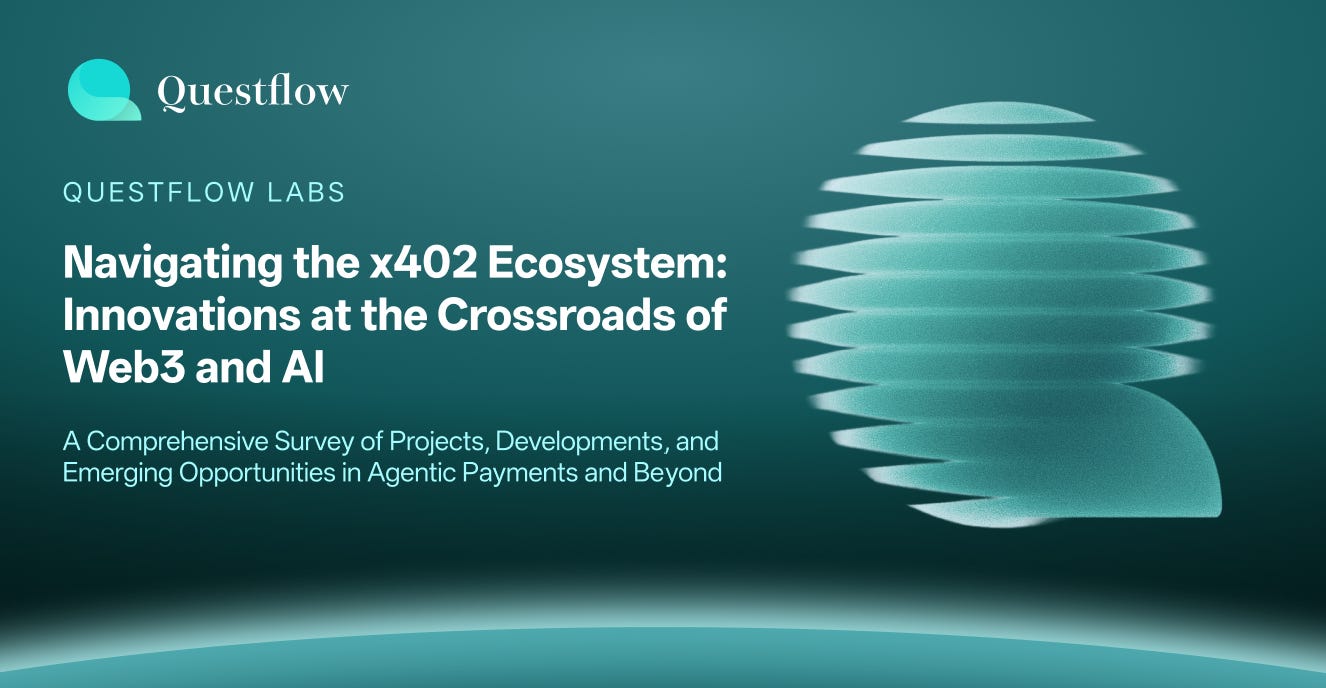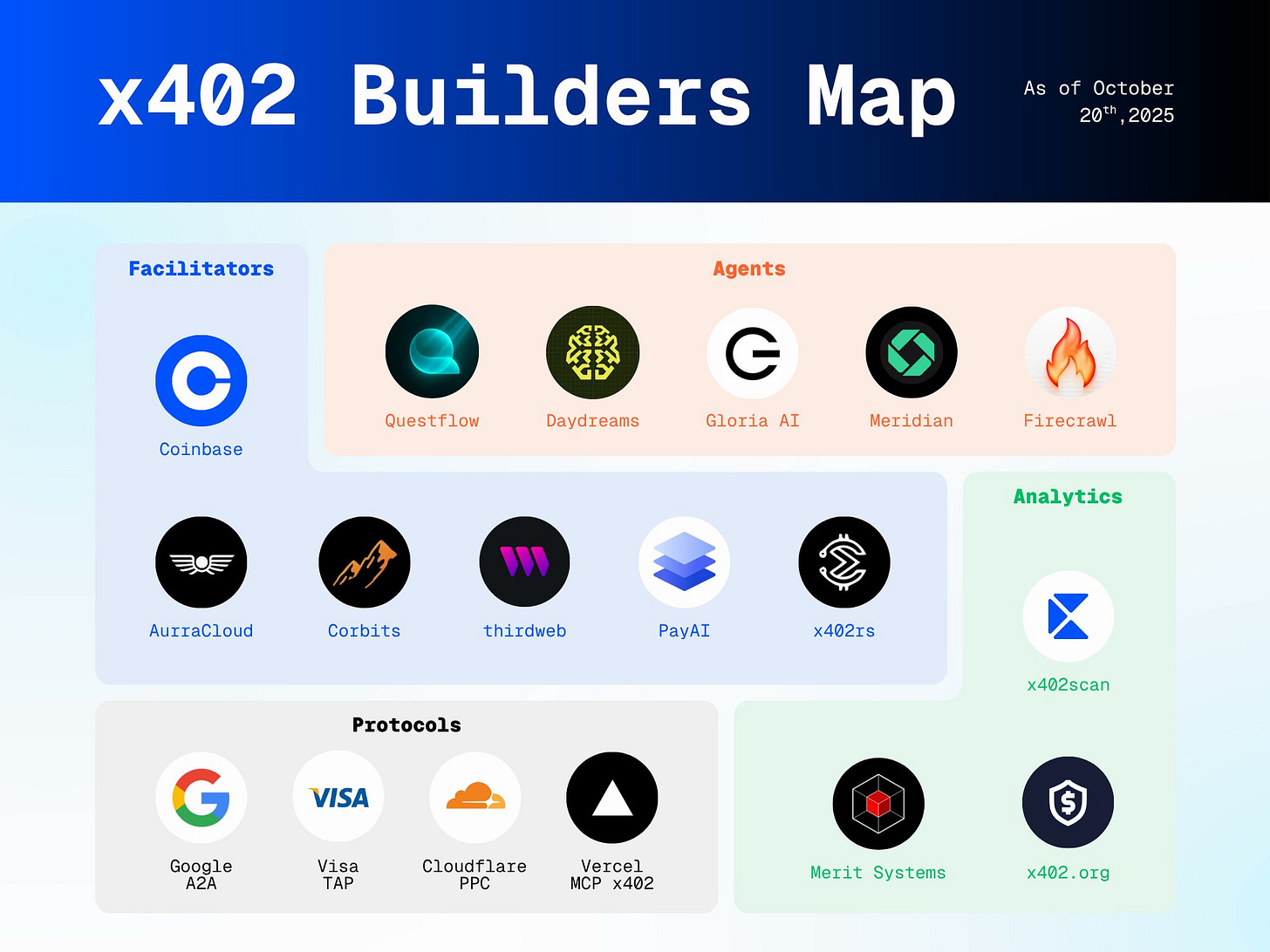Navigating the x402 Ecosystem: Innovations at the Crossroads of Web3 and AI
A Comprehensive Survey of Projects, Developments, and Emerging Opportunities in Agentic Payments and Beyond
Introduction to the x402 Ecosystem
In the rapidly evolving intersection of Web3 and artificial intelligence (AI), few developments have captured as much attention as the x402 protocol. Launched by Coinbase in early 2025, x402 revives the long-dormant HTTP 402 “Payment Required” status code to enable seamless, programmatic micropayments using stablecoins like USDC. This protocol is not just a technical curiosity; it’s a foundational layer for the “agentic economy,” where AI agents can autonomously transact without human intervention, KYC, or traditional subscription models.
Today, the x402 ecosystem has grown from a niche experiment into a vibrant network of facilitators, agents, analytics tools, and protocols. Backed by giants like Coinbase, Google, Visa, Cloudflare, and Vercel, it addresses a critical pain point in AI-Web3 integration: how to monetize APIs and services in real-time for low-frequency, high-variety interactions. This is particularly relevant for AI agents, which operate 24/7 but often make unpredictable calls to external services.
The ecosystem’s development has been meteoric. Since its open-source release on GitHub, adoption has spiked, with significant usage growth reported by analytics platforms like x402scan. For instance, over the past 90 days, the ecosystem has seen 52.4K transactions (up 93.3%), a total volume of $521.1K (up 4120.38%), 991 buyers (up 279.6%), and 244 sellers (up 75.5%). Chains like Base, Solana, Polygon, and Algorand have integrated it, enabling cross-chain micropayments. Projects span from payment facilitators to AI-driven agents, driven by AI agent adoption.
This survey aims to provide Web3 and AI enthusiasts with a thorough understanding of x402’s current state, key projects, their features and capabilities, performance data, and future opportunities. We’ll break down the ecosystem into its core categories—Facilitators, Agents, Analytics, and Protocols—drawing on real-time data from sources like x402scan, Dune Analytics, and on-chain metrics. By the end, readers will grasp not only the technical underpinnings but also the investment and innovation potentials in this space.
Historical Context and Overall Ecosystem Development
The genesis of x402 traces back to Coinbase’s vision for an “internet-native payment layer.” Announced in late 2024, it built on existing standards like EIP-3009 for signed authorizations and Base’s Layer 2 scaling for millisecond settlements. The protocol allows a server to respond to an API request with a 402 code, including payment details (e.g., price in USDC, recipient address), which the client (often an AI agent) fulfills autonomously via a smart wallet.
Key milestones:
January 2025: Open-source launch on GitHub, with initial integrations from Coinbase Developer Platform (CDP).
March 2025: Partnerships with Google (via Agent Payments Protocol 2 or AP2), Visa (Tokenized Asset Platform or TAP), and Cloudflare (Pay-Per-Compute or PPC).
June 2025: Hackathon series yields over 200 projects, including agents like Questflow and analytics tools like x402scan.
September 2025: Formation of the x402 Foundation by Coinbase and Cloudflare for independent governance, standardizing the protocol across Web3 chains.
October 2025: Ecosystem map release (as visualized in recent builder maps), showing 50+ active projects and chains like Algorand integrating via Plausible.
Development metrics highlight robust growth. Base leads in volume, followed by Solana and Polygon, per DefiLlama data. AI agents like Gloria AI and Questflow signal AI’s role in driving adoption, with Questflow standing out as a top performer in transaction volumes.
Challenges include facilitator competition (15+ options, many free) and provider scarcity (only 30+ services integrated, mostly community-driven). However, this creates opportunities for builders: low barriers to entry for new agents and high margins in encapsulating non-native services.
Economically, x402 disrupts subscription models. Traditional SaaS wastes 70-80% of quotas on idle usage; x402’s pay-per-use saves costs for light users while monetizing idle compute. Projections suggest the Web3 market could reach $41.45 billion by 2030, with x402 capturing a portion via AI infrastructure.
Category 1: Agents – AI-Powered Executors in x402
Agents leverage x402 for autonomous tasks, from data scraping to transactions, embodying the “agentic economy.”
Questflow
Features and Capabilities: Orchestrates multi-agent workflows. Uses x402 for API monetization. Capabilities: Swarm intelligence for complex tasks (e.g., market analysis), integration with 20+ LLMs via routers. With a no-code AI workflow engine, x402-powered payments, and deep integrations across Web2 and Web3, Questflow enables developers and users to orchestrate rich onchain actions — all through autonomous agents.
Data and Performance: Leading contributor, with 48.25K transactions, $2.29K volume, and 1.25K buyers over the past 90 days, associated with 62 addresses and latest activity 5 minutes ago via Coinbase facilitator. Activity trends show consistent high engagement.
Opportunities: Core to AI-Web3 fusion; potential for P2P agent markets.
Daydreams
Features and Capabilities: Omnichain agents on Base, Solana, Starknet. Router encapsulates non-x402 LLMs (e.g., OpenAI) for pay-per-use. Framework simplifies agent building with budget controls.
Data and Performance: Active in encapsulating services.
Opportunities: Best product-market fit for encapsulating legacy services; potential in agent proliferation.
Gloria AI
Features and Capabilities: AI news and data terminal. Provides real-time crypto insights via x402. Capabilities: Virtuals integration for on-chain analysis, ACP support for agentic payments.
Data and Performance: Notable contributor in the ecosystem.
Opportunities: News-as-a-service for agents; expansion to SIEM (Security Information and Event Management).
Meridian (Agent Layer)
Features and Capabilities: Beyond facilitation, offers agent rails for stack-wide value capture. Compatible with Questflow orchestration.
Data and Performance: Integrated in multiple projects; fee model yields sustainable revenue.
Opportunities: Infrastructure play; undervalued at current levels.
Firecrawl
Features and Capabilities: Web scraping agent. Uses x402 for pay-per-scrape. Capabilities: Real-time data extraction, integration with analytics.
Data and Performance: Growing adoption.
Opportunities: Essential for data-hungry AI; synergies with RWA projects.
Other agents like Karum AI and Ethy focus on niche tasks (e.g., governance, yield farming).
Agents drive a significant portion of x402 volume, highlighting AI’s pivotal role.
Category 2: Facilitators – The Payment Rails of x402
Facilitators are the backbone, handling signature verification, transaction broadcasting, and gas abstraction. They enable agents to pay without friction, often at zero cost to compete.
Coinbase Facilitator
Features and Capabilities: As the protocol’s originator, it uses Coinbase Smart Wallets for EIP-3009 signatures. Supports Base chain exclusively, with zero fees and seamless USDC integration. Capabilities include batch payments and real-time settlements (under 1 second).
Data and Performance: Processes a significant portion of ecosystem volume. High uptime reported.
Opportunities: Ideal for Base-native AI agents. Future: Expansion to multi-chain via bridges like Allbridge.
PayAI
Features and Capabilities: Multi-chain (Solana, Base, others) facilitator with zero fees. Includes AI-optimized routing for lowest-cost paths. Capabilities: Governance features for fee rebates, integration with agent frameworks like Daydreams.
Data and Performance: Active in the ecosystem with growing adoption.
Opportunities: Plays in AI payments; potential upside in bull runs, per analyst projections.
Meridian
Features and Capabilities: Enterprise-grade with 1% withdrawal fee. Offers organizational dashboards, audit logs, and permission controls. Compatible with Google’s AP2 and ERC-8004. Capabilities: Self-funding treasury via fees, 2% cashback for early users (halving over time).
Data and Performance: Focused on high-value transactions.
Opportunities: Targets B2B; could capture value as agents scale to corporate use. Risks: Higher fees may limit retail adoption.
Other facilitators like x402.org (open-source, self-hosted) provide zero-fee alternatives, fostering decentralization but fragmenting liquidity.
Overall, facilitators’ low barriers (anyone can build one) suggest commoditization, with value accruing to integrated ecosystems like PayAI’s.
Category 3: Analytics – Monitoring and Insights for x402
Analytics tools provide visibility into payments, usage, and performance.
AuroraCloud
Features and Capabilities: Cloud-based analytics for agent metrics. Dashboards for TVL, transaction flows.
Data and Performance: Tracks numerous data points daily. High uptime.
Opportunities: AI-enhanced predictions; integration with Dune for broader Web3 insights.
Corbits
Features and Capabilities: Orbital analytics for chain data. Visualizes x402 flows across ecosystems.
Data and Performance: Partnerships with thirdweb.
Opportunities: Cross-chain visibility; potential for ML anomaly detection.
Thirdweb
Features and Capabilities: Web3 dev toolkit with x402 analytics. Monitors smart contract interactions.
Data and Performance: Used in numerous hackathon projects.
Opportunities: Builder-focused; growth via Vercel integrations.
x402scan
Features and Capabilities: x402scan (by Merit Systems) is the ecosystem explorer: usage metrics, resource tracking. x402rs: Research suite for facilitators. All analytics are powered by the new CoinbaseDev SQL API. On-chain data alone doesn’t paint the full picture, but x402scan helps track growth in agentic commerce.
Data and Performance: Open-source.
Opportunities: Community contributions; becoming the “Dune” of x402.
Analytics reveal ecosystem health, with growth in engagements.
Category 4: Protocols – Foundational Layers
Protocols standardize x402 across infrastructures.
Google A2A (AP2)
Features and Capabilities: Agent Payments Protocol 2 integrates with x402 for AI autonomy. Capabilities: Cross-system compatibility.
Data and Performance: Collabs with Algorand.
Opportunities: Enterprise adoption; bridges AI giants to Web3.
Visa TAP
Features and Capabilities: Tokenized assets via x402. Capabilities: Fiat-onramp for agents.
Data and Performance: Global expansion.
Opportunities: RWA integration; mass adoption catalyst.
Cloudflare PPC
Features and Capabilities: Pay-Per-Compute for idle resources. Capabilities: Micropayments for edge computing.
Data and Performance: Compute hours monetized.
Opportunities: Decentralized compute; AI training synergies.
Vercel MCP x402
Features and Capabilities: Managed Compute Protocol with x402. Capabilities: Serverless agent hosting.
Data and Performance: Projects launched.
Opportunities: Dev-friendly; scaling to MCP standards.
Merit Systems
Features and Capabilities: Financial stack for open-source. Integrates x402scan.
Data and Performance: Contributor growth.
Opportunities: OSS monetization; agent rewards.
x402.org
Features and Capabilities: Core protocol hub. Governance and standards.
Data and Performance: Foundation-backed; multiple facilitators.
Opportunities: Decentralized evolution.
Protocols handle a portion of volume, ensuring interoperability.
Data Overview and Ecosystem Metrics
Aggregated data from sources like DefiLlama, Dune: Over the past 90 days, 52.4K transactions (up 93.3%), $521.1K volume (up 4120.38%), 991 buyers (up 279.6%), 244 sellers (up 75.5%). Challenges: Provider resistance to pay-per-use (70% idle quota profits lost).
Future Opportunities and Potential
x402’s potential lies in:
Agentic Commerce: Opportunities in P2P agent markets.
RWA and DeFi: Integrations like Plausible on Algorand.
AI Infrastructure: Encapsulating LLMs (Daydreams model).
Investment Plays: Undervalued projects like Meridian (enterprise), Gloria AI (data).
Risks: Fragmentation, regulatory hurdles (e.g., AML for agents).
Builders: Focus on providers; leverage hackathons for grants.
Investors: Bet on facilitators with moats (e.g., PayAI’s multi-chain) and agents with PMF (Daydreams).
Spotlight on Questflow: Leading the x402 Ecosystem with Superior Performance
Among the standout projects in the x402 ecosystem, Questflow deserves special attention for its exceptional performance, as evidenced by leading metrics. As the top server in the bazaar, Questflow’s api.questflow.ai has handled 48.25K transactions, generating $2.29K in volume from 1.25K buyers across 62 addresses, with the latest activity just 5 minutes ago through the Coinbase facilitator. Activity trends display strong, consistent peaks, reflecting high engagement and reliability in agentic workflows.
Questflow’s integration with x402 enables agents to pay one another for services and data without user intervention, gas fees, or manual signing, making it a cornerstone for the multi-agent economy. With features like no-code workflow orchestration and deep Web2/Web3 integrations, it boasts a strong user base, particularly in communities like Algoland. Funding-wise, Questflow has raised $6.5 million across three rounds from investors including Animoca Brands, CyberFund, CatcherVC, Delphi Labs, Systemic Ventures, Eden Block, White Star Capital, HashKey Capital, and others, fueling its growth and open-source contributions, such as the qf-x402 repository on GitHub.
Compared to peers like Gloria AI, Questflow’s metrics highlight its efficiency: higher throughput, broader adoption, and innovative benchmarks focusing on user-centric success rather than just correctness. This positions Questflow not only as a leader in current x402 usage but also as a high-potential opportunity for investors and builders. As the ecosystem evolves, Questflow’s emphasis on real-world incentives for autonomous agents could drive the next wave of adoption, potentially unlocking billions in value within the $41 billion projected Web3 market. For those eyeing entry points, monitoring Questflow’s metrics on x402scan is essential—its trajectory suggests it’s at the forefront of transforming agentic commerce.





This article comes at the perfect time, thanks for shedding light on the x402 protcol; it's clear this foundational layer for autonomous AI agents is exactly what the Web3 space needed, and your explanation made it so much easier to grasp.